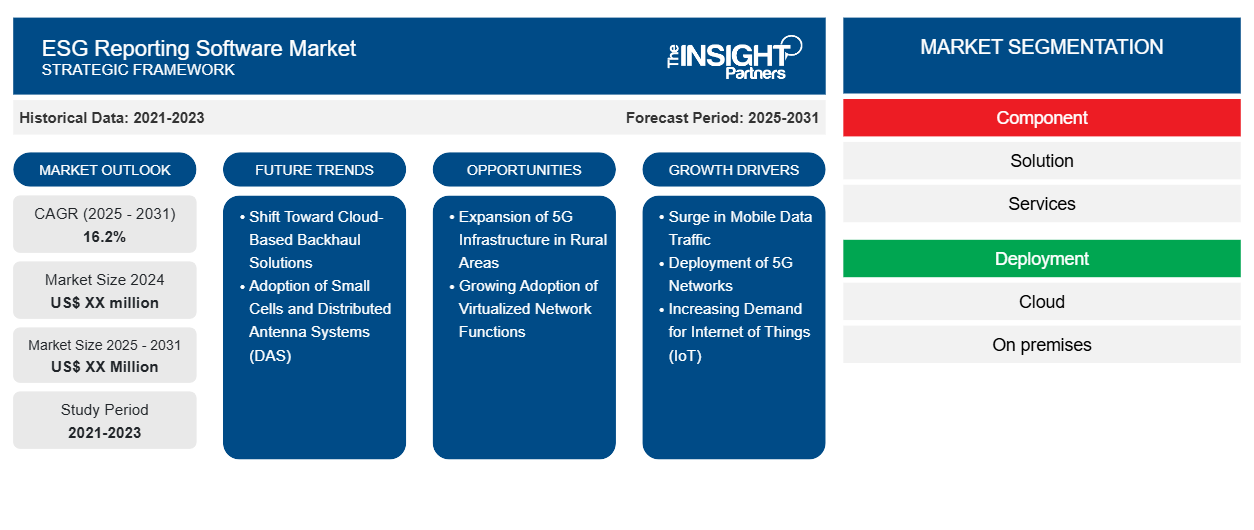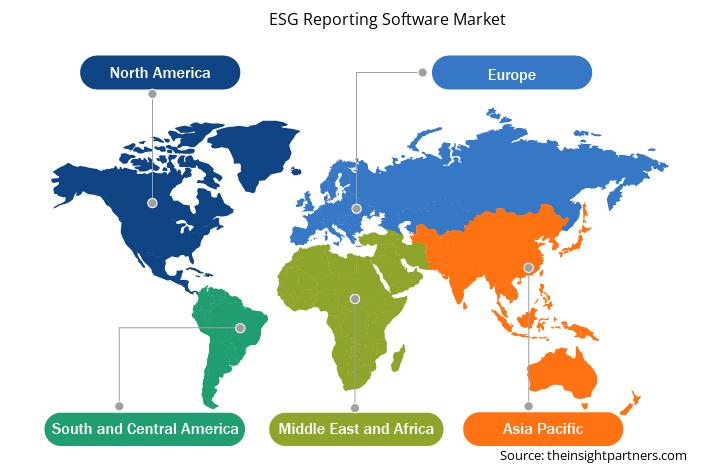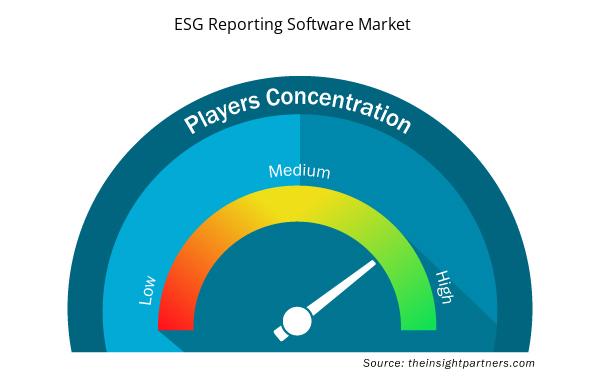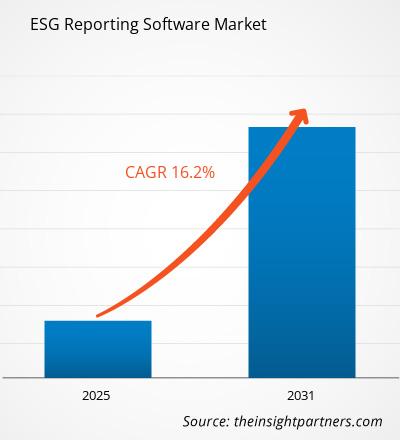Für den Markt für ESG-Reporting-Software wird von 2025 bis 2031 eine durchschnittliche jährliche Wachstumsrate (CAGR) von 16,2 % erwartet, wobei die Marktgröße von XX Millionen US-Dollar im Jahr 2024 auf XX Millionen US-Dollar im Jahr 2031 anwachsen wird.
Der Bericht ist segmentiert nach Komponenten (Lösungen, Services); Bereitstellung (Cloud, On-Premises); Unternehmensgröße (Großunternehmen, KMU); Endnutzer (IT und Telekommunikation, Gesundheitswesen, Fertigung, Einzelhandel und E-Commerce, Behörden, BFSI, Sonstige). Die globale Analyse wird weiter nach Regionen und wichtigen Ländern aufgeschlüsselt. Der Bericht bietet den Wert in USD für die oben genannten Analysen und Segmente.
Zweck des Berichts
Der Bericht „ESG Reporting Software Market“ von The Insight Partners beschreibt die aktuelle Situation und das zukünftige Wachstum sowie die wichtigsten Treiber, Herausforderungen und Chancen. Dies bietet verschiedenen Stakeholdern Einblicke, beispielsweise:
- Technologieanbieter/-hersteller: Um die sich entwickelnde Marktdynamik zu verstehen und die potenziellen Wachstumschancen zu kennen, können sie fundierte strategische Entscheidungen treffen.
- Investoren: Um eine umfassende Trendanalyse hinsichtlich der Marktwachstumsrate, der finanziellen Marktprognosen und der Chancen entlang der Wertschöpfungskette durchzuführen.
- Regulierungsbehörden: Sie regulieren die Richtlinien und polizeilichen Aktivitäten auf dem Markt mit dem Ziel, Missbrauch zu minimieren, das Vertrauen der Anleger zu wahren und die Integrität und Stabilität des Marktes aufrechtzuerhalten.
Marktsegmentierung für ESG-Reporting-Software
Komponente
- Lösung
- Leistungen
Einsatz
- Wolke
- Vor Ort
Unternehmensgröße
- Große Unternehmen
- KMU
Endbenutzer
- IT und Telekommunikation
- Gesundheitspflege
- Herstellung
- Einzelhandel und E-Commerce
- Regierung
- BFSI
Passen Sie diesen Bericht Ihren Anforderungen an
Sie erhalten kostenlos Anpassungen an jedem Bericht, einschließlich Teilen dieses Berichts oder einer Analyse auf Länderebene, eines Excel-Datenpakets sowie tolle Angebote und Rabatte für Start-ups und Universitäten
Markt für ESG-Reporting-Software: Strategische Einblicke

- Informieren Sie sich über die wichtigsten Markttrends in diesem Bericht.Dieses KOSTENLOSE Beispiel umfasst Datenanalysen, von Markttrends bis hin zu Schätzungen und Prognosen.
Wachstumstreiber auf dem Markt für ESG-Reporting-Software
- Steigender mobiler Datenverkehr: Das exponentielle Wachstum des mobilen Datenverkehrs, angetrieben durch die zunehmende Nutzung von Smartphones, mobilen Apps und Video-Streaming, ist ein wichtiger Treiber für den mobilen und drahtlosen Backhaul-Markt. Da Mobilfunkbetreiber schnellere und zuverlässigere Datendienste anbieten möchten, benötigen sie effiziente und skalierbare Backhaul-Lösungen, um diesen Anstieg des Datenverkehrs zu bewältigen und das Marktwachstum voranzutreiben.
- Ausbau von 5G-Netzen: Die weltweite Einführung der 5G-Technologie treibt den Markt für mobile und drahtlose Backhaul-Verbindungen maßgeblich voran. 5G-Netze erfordern Backhaul-Lösungen mit hoher Kapazität und geringer Latenz, um die massive Steigerung der Datengeschwindigkeit, der Gerätekonnektivität und der hochzuverlässigen Kommunikation zu unterstützen. Diese Nachfrage nach Konnektivitätslösungen der nächsten Generation beflügelt den Markt.
- Steigende Nachfrage nach dem Internet der Dinge (IoT): Die rasante Verbreitung von IoT-Geräten erfordert robuste, leistungsstarke mobile und drahtlose Backhaul-Systeme. Milliarden vernetzter Geräte benötigen einen reibungslosen Datentransfer. Daher steigt die Nachfrage nach fortschrittlichen Backhaul-Technologien zur Bewältigung des gestiegenen Datenverkehrs und treibt das Marktwachstum voran.
Zukünftige Trends auf dem Markt für ESG-Reporting-Software
- Umstellung auf Cloud-basierte Backhaul-Lösungen: Ein wichtiger Trend im mobilen und drahtlosen Backhaul-Markt ist die Umstellung auf Cloud-basierte Backhaul-Lösungen. Cloud-Technologien ermöglichen skalierbare, flexible und kostengünstige Backhaul-Dienste und reduzieren den Bedarf an teurer physischer Infrastruktur. Dieser Trend gewinnt an Bedeutung, da Mobilfunkbetreiber und Serviceprovider Cloud-basierte Lösungen für verbesserte Leistung und Flexibilität nutzen.
- Einführung von Kleinzellen und verteilten Antennensystemen (DAS): Der zunehmende Einsatz von Kleinzellen und verteilten Antennensystemen (DAS) verändert die Architektur mobiler Backhaul-Netze. Diese Technologien tragen dazu bei, die Netzabdeckung zu verbessern, Überlastungen zu reduzieren und die Netzwerkkapazität zu erhöhen, insbesondere in dicht besiedelten städtischen Gebieten. Die Einführung von Kleinzellen und DAS ist ein wichtiger Trend, der den Bedarf an effizienteren und leistungsstärkeren Backhaul-Lösungen vorantreibt.
Marktchancen für ESG-Reporting-Software
- Ausbau der 5G-Infrastruktur in ländlichen Gebieten: Der Ausbau der 5G-Infrastruktur in ländlichen und unterversorgten Regionen bietet eine große Chance für den Markt für mobile und drahtlose Backhaul-Dienste. Da dort fortschrittliche Backhaul-Systeme zur Unterstützung von 5G benötigt werden, bietet sich die Möglichkeit, innovative, auf diese aufstrebenden Märkte zugeschnittene Lösungen anzubieten und so die Nachfrage nach mobilen Backhaul-Diensten zu steigern.
- Zunehmende Nutzung virtualisierter Netzwerkfunktionen: Die zunehmende Nutzung von Netzwerkfunktionsvirtualisierung (NFV) und Software-Defined Networking (SDN) eröffnet dem mobilen und drahtlosen Backhaul-Markt neue Möglichkeiten. Virtualisierte Lösungen bieten mehr Flexibilität, geringere Kosten und schnellere Bereitstellungszeiten und ermöglichen es Anbietern, dynamische, leistungsstarke Backhaul-Dienste bereitzustellen.
Regionale Einblicke in den Markt für ESG-Reporting-Software
Die Analysten von Insight Partners haben die regionalen Trends und Faktoren, die den Markt für ESG-Reporting-Software im Prognosezeitraum beeinflussen, ausführlich erläutert. In diesem Abschnitt werden auch die Marktsegmente und die geografische Lage von ESG-Reporting-Software in Nordamerika, Europa, Asien-Pazifik, dem Nahen Osten und Afrika sowie Süd- und Mittelamerika erläutert.

- Erhalten Sie regionale Daten zum Markt für ESG-Reporting-Software
Umfang des Marktberichts zur ESG-Reporting-Software
| Berichtsattribut | Details |
|---|---|
| Marktgröße im Jahr 2024 | XX Millionen US-Dollar |
| Marktgröße bis 2031 | XX Millionen US-Dollar |
| Globale CAGR (2025 – 2031) | 16,2 % |
| Historische Daten | 2021-2023 |
| Prognosezeitraum | 2025–2031 |
| Abgedeckte Segmente | Nach Komponente
|
| Abgedeckte Regionen und Länder | Nordamerika
|
| Marktführer und wichtige Unternehmensprofile |
|
Marktteilnehmerdichte für ESG-Reporting-Software: Auswirkungen auf die Geschäftsdynamik verstehen
Der Markt für ESG-Reporting-Software wächst rasant. Die steigende Nachfrage der Endnutzer ist auf Faktoren wie veränderte Verbraucherpräferenzen, technologische Fortschritte und ein stärkeres Bewusstsein für die Produktvorteile zurückzuführen. Mit der steigenden Nachfrage erweitern Unternehmen ihr Angebot, entwickeln Innovationen, um den Bedürfnissen der Verbraucher gerecht zu werden, und nutzen neue Trends, was das Marktwachstum weiter ankurbelt.
Die Marktteilnehmerdichte beschreibt die Verteilung der in einem bestimmten Markt oder einer bestimmten Branche tätigen Unternehmen. Sie gibt an, wie viele Wettbewerber (Marktteilnehmer) in einem bestimmten Marktraum im Verhältnis zu dessen Größe oder Gesamtmarktwert präsent sind.
Die wichtigsten Unternehmen auf dem Markt für ESG-Reporting-Software sind:
- Wolters Kluwer NV
- Nasdaq, Inc.
- PricewaterhouseCoopers LLP (PwC)
- Workiva, Inc.
- London Stock Exchange Group PLC
- Datamaran
Haftungsausschluss : Die oben aufgeführten Unternehmen sind nicht in einer bestimmten Reihenfolge aufgeführt.

- Überblick über die wichtigsten Akteure auf dem Markt für ESG-Reporting-Software
Wichtige Verkaufsargumente
- Umfassende Abdeckung: Der Bericht deckt die Analyse von Produkten, Diensten, Typen und Endbenutzern des ESG-Reporting-Software-Marktes umfassend ab und bietet eine ganzheitliche Landschaft.
- Expertenanalyse: Der Bericht basiert auf dem umfassenden Verständnis von Branchenexperten und Analysten.
- Aktuelle Informationen: Der Bericht gewährleistet Geschäftsrelevanz durch die Berichterstattung über aktuelle Informationen und Datentrends.
- Anpassungsoptionen: Dieser Bericht kann angepasst werden, um den spezifischen Kundenanforderungen gerecht zu werden und die Geschäftsstrategien optimal anzupassen.
Der Forschungsbericht zum Markt für ESG-Reporting-Software kann daher dazu beitragen, die Branchensituation und die Wachstumsaussichten zu entschlüsseln und zu verstehen. Obwohl es einige berechtigte Bedenken geben mag, überwiegen die Vorteile dieses Berichts tendenziell die Nachteile.
- Historische Analyse (2 Jahre), Basisjahr, Prognose (7 Jahre) mit CAGR
- PEST- und SWOT-Analyse
- Marktgröße Wert/Volumen – Global, Regional, Land
- Branche und Wettbewerbsumfeld
- Excel-Datensatz



Report Coverage
Revenue forecast, Company Analysis, Industry landscape, Growth factors, and Trends

Segment Covered
This text is related
to segments covered.

Regional Scope
North America, Europe, Asia Pacific, Middle East & Africa, South & Central America

Country Scope
This text is related
to country scope.
Häufig gestellte Fragen
Some of the customization options available based on the request are an additional 3–5 company profiles and country-specific analysis of 3–5 countries of your choice. Customizations are to be requested/discussed before making final order confirmation# as our team would review the same and check the feasibility
The report can be delivered in PDF/PPT format; we can also share excel dataset based on the request
Integration of AI and machine learning capabilities and real-time ESG data integration are anticipated to play a significant role in the global ESG reporting software market in the coming years
Intensifying regulatory compliance requirement, growing investor pressure for ESG Transparency, and rising corporate commitment to sustainability goals are the major factors driving the ESG reporting software market.
The global ESG reporting software market is expected to grow at a CAGR of 16.2% during the forecast period 2024 - 2031.
Trends and growth analysis reports related to Technology, Media and Telecommunications : READ MORE..
The Insight Partners performs research in 4 major stages: Data Collection & Secondary Research, Primary Research, Data Analysis and Data Triangulation & Final Review.
- Data Collection and Secondary Research:
As a market research and consulting firm operating from a decade, we have published and advised several client across the globe. First step for any study will start with an assessment of currently available data and insights from existing reports. Further, historical and current market information is collected from Investor Presentations, Annual Reports, SEC Filings, etc., and other information related to company’s performance and market positioning are gathered from Paid Databases (Factiva, Hoovers, and Reuters) and various other publications available in public domain.
Several associations trade associates, technical forums, institutes, societies and organization are accessed to gain technical as well as market related insights through their publications such as research papers, blogs and press releases related to the studies are referred to get cues about the market. Further, white papers, journals, magazines, and other news articles published in last 3 years are scrutinized and analyzed to understand the current market trends.
- Primary Research:
The primarily interview analysis comprise of data obtained from industry participants interview and answers to survey questions gathered by in-house primary team.
For primary research, interviews are conducted with industry experts/CEOs/Marketing Managers/VPs/Subject Matter Experts from both demand and supply side to get a 360-degree view of the market. The primary team conducts several interviews based on the complexity of the markets to understand the various market trends and dynamics which makes research more credible and precise.
A typical research interview fulfils the following functions:
- Provides first-hand information on the market size, market trends, growth trends, competitive landscape, and outlook
- Validates and strengthens in-house secondary research findings
- Develops the analysis team’s expertise and market understanding
Primary research involves email interactions and telephone interviews for each market, category, segment, and sub-segment across geographies. The participants who typically take part in such a process include, but are not limited to:
- Industry participants: VPs, business development managers, market intelligence managers and national sales managers
- Outside experts: Valuation experts, research analysts and key opinion leaders specializing in the electronics and semiconductor industry.
Below is the breakup of our primary respondents by company, designation, and region:

Once we receive the confirmation from primary research sources or primary respondents, we finalize the base year market estimation and forecast the data as per the macroeconomic and microeconomic factors assessed during data collection.
- Data Analysis:
Once data is validated through both secondary as well as primary respondents, we finalize the market estimations by hypothesis formulation and factor analysis at regional and country level.
- Macro-Economic Factor Analysis:
We analyse macroeconomic indicators such the gross domestic product (GDP), increase in the demand for goods and services across industries, technological advancement, regional economic growth, governmental policies, the influence of COVID-19, PEST analysis, and other aspects. This analysis aids in setting benchmarks for various nations/regions and approximating market splits. Additionally, the general trend of the aforementioned components aid in determining the market's development possibilities.
- Country Level Data:
Various factors that are especially aligned to the country are taken into account to determine the market size for a certain area and country, including the presence of vendors, such as headquarters and offices, the country's GDP, demand patterns, and industry growth. To comprehend the market dynamics for the nation, a number of growth variables, inhibitors, application areas, and current market trends are researched. The aforementioned elements aid in determining the country's overall market's growth potential.
- Company Profile:
The “Table of Contents” is formulated by listing and analyzing more than 25 - 30 companies operating in the market ecosystem across geographies. However, we profile only 10 companies as a standard practice in our syndicate reports. These 10 companies comprise leading, emerging, and regional players. Nonetheless, our analysis is not restricted to the 10 listed companies, we also analyze other companies present in the market to develop a holistic view and understand the prevailing trends. The “Company Profiles” section in the report covers key facts, business description, products & services, financial information, SWOT analysis, and key developments. The financial information presented is extracted from the annual reports and official documents of the publicly listed companies. Upon collecting the information for the sections of respective companies, we verify them via various primary sources and then compile the data in respective company profiles. The company level information helps us in deriving the base number as well as in forecasting the market size.
- Developing Base Number:
Aggregation of sales statistics (2020-2022) and macro-economic factor, and other secondary and primary research insights are utilized to arrive at base number and related market shares for 2022. The data gaps are identified in this step and relevant market data is analyzed, collected from paid primary interviews or databases. On finalizing the base year market size, forecasts are developed on the basis of macro-economic, industry and market growth factors and company level analysis.
- Data Triangulation and Final Review:
The market findings and base year market size calculations are validated from supply as well as demand side. Demand side validations are based on macro-economic factor analysis and benchmarks for respective regions and countries. In case of supply side validations, revenues of major companies are estimated (in case not available) based on industry benchmark, approximate number of employees, product portfolio, and primary interviews revenues are gathered. Further revenue from target product/service segment is assessed to avoid overshooting of market statistics. In case of heavy deviations between supply and demand side values, all thes steps are repeated to achieve synchronization.
We follow an iterative model, wherein we share our research findings with Subject Matter Experts (SME’s) and Key Opinion Leaders (KOLs) until consensus view of the market is not formulated – this model negates any drastic deviation in the opinions of experts. Only validated and universally acceptable research findings are quoted in our reports.
We have important check points that we use to validate our research findings – which we call – data triangulation, where we validate the information, we generate from secondary sources with primary interviews and then we re-validate with our internal data bases and Subject matter experts. This comprehensive model enables us to deliver high quality, reliable data in shortest possible time.

 Holen Sie sich ein kostenloses Muster für diesen Bericht
Holen Sie sich ein kostenloses Muster für diesen Bericht